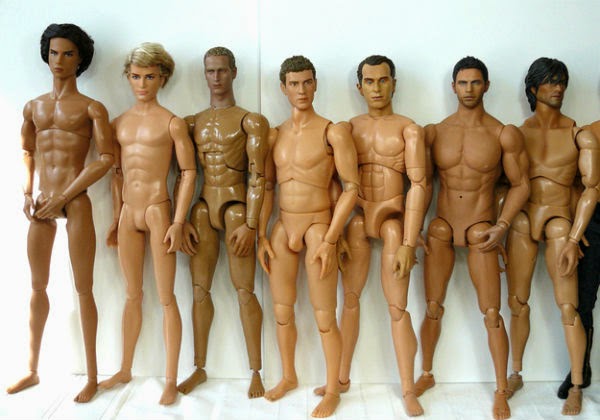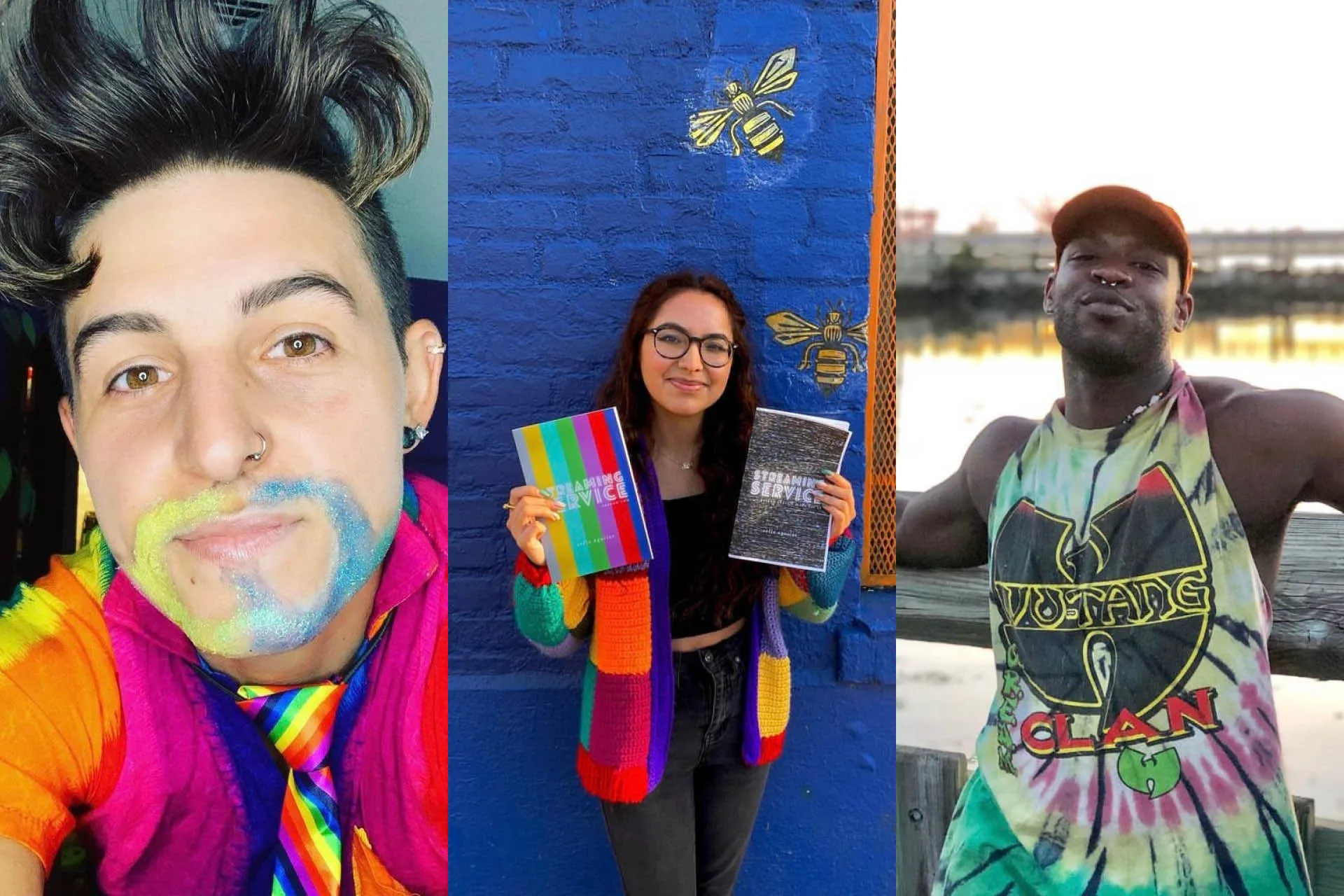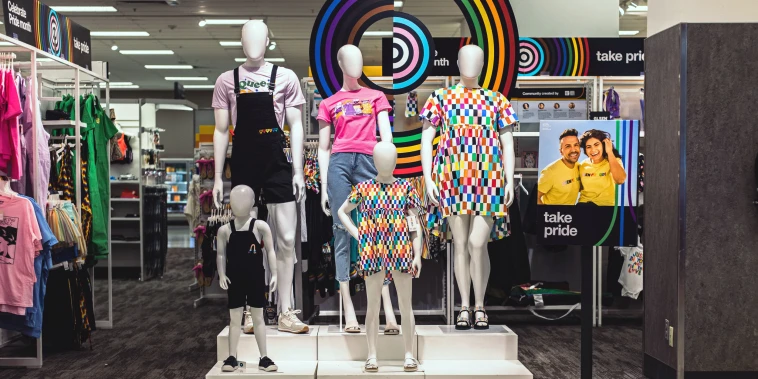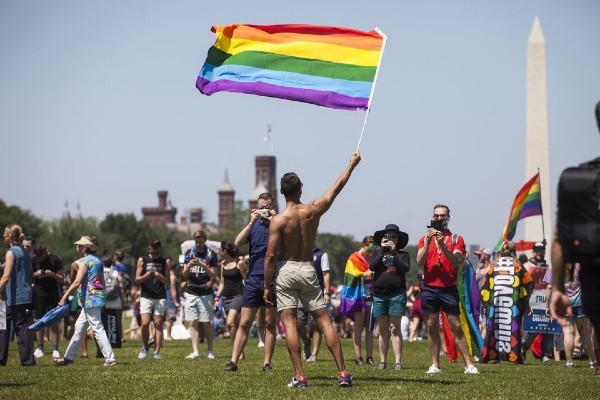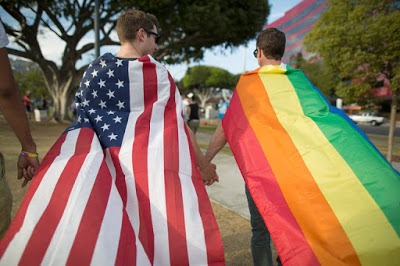
Each year, the rainbow flag is flown at Pride events all around a world to reflect the beauty and diversity of the LGBTQ+ community.
More Colour. More Pride.
Each year, the rainbow flag is flown at Pride events all around a world to reflect the beauty and diversity of the LGBTQ+ community.
Since artist and gay rights activist Gilbert Baker created the original flag in 1978, various designers and advocates have made different (or updated) variations of the flag to better represent individual communities. There has been pushback, however, from members of the community who argue that the original Pride flag encompasses and celebrates all identities. NEWSFLASH PEOPLE: one flag would be a snooze-fest!
When we spoke to Amber Hikes, developer of the eight-stripe More Colour More Pride flag, she explained the importance of individual symbols for LGBTQ+ sub-cultures – and she did it beautifully. “This eight-stripe flag is not a replacement, in the same way that that those other flags didn’t replace the original. Instead it is a way to symbolise, to highlight, and to stand in solidarity with these other identities,” she told GAY TIMES.
“That is literally the purpose of any flag we have – to stand as a symbol for an identity, whether it’s a country, a municipality, a company, it stands as a symbol to recognise and highlight the experiences of this entity. The existence of this flag doesn’t take away from anybody else’s identity. It only adds to great inclusion.”
We’ve collected a list of the Pride flags that have become synonymous with various identities in our vibrant community. Of course, this list isn’t exhaustive because flags are always being devised to reflect different sub-cultures, but hopefully this will useful for the next time you see one of these gorgeous symbols being flown at the next Pride event.

Gilbert Baker Pride Flag
First unveiled at the San Francisco Gay and Lesbian Freedom Day Parade on 25 June 1978, the flag was created by American artist and gay rights activist Gilbert Baker to reflect the diversity of the LGBTQ+ community. According to Baker, pink represents sex, red for life, orange for healing, yellow for sun, green for nature, turquoise for magic, blue for serenity and purple for spirit. Following his death in 2017, California state senator Scott Wiener said Baker was instrumental in defining “the modern LGBT movement”.

Traditional Pride Flag
In 1979, the pink and turquoise stripes were ditched from Baker’s version for a resulting six-stripe flag, which is now the version people are most familiar with. According to reports, the pink was removed because of difficulties obtaining fabric and the turquoise was removed because of complications relating to having an odd number of colours.

More Colour, More Pride Flag
To better represent LGBTQ+ people of colour and their experiences, Philadelphia-based campaign group More Colour More Pride debuted a brand new eight-stripe flag in 2017 to coincide with Pride Month. You can read our interview with Amber Hikes, Executive Director of the Mayor’s Office for LGBT Affairs in Philadelphia and developer of the flag, in which she explains the importance of the eight stripes, here.

Progress Pride Flag
The rainbow flag was updated once again in 2018 by Daniel Quasar, a graphic designer and activist. This new variation was designed to better recognise the trans community, queer people of colour and to honour the lives of those who died due to AIDS complications. Quasar, who is queer and non-binary, said their aim was to “shift focus and emphasis to what is important in our current community climate.”

Transgender Pride Flag
The Transgender Pride Flag was created by Monica Helms, an openly transgender woman, in 1999. It includes the two colours that are traditionally associated with baby girls (pale pink) and baby boys (pale blue) with a white stripe in the middle, which represents those who are intersex or transitioning. Andy Campbell’s book Queer X Design also states that it represents members of the community who “consider themselves having a neutral or undefined gender.”

Genderqueer Pride Flag
Designed in 2011 by genderqueer writer and activist Marilyn Roxie, the Genderqueer Pride Flag features three stripes: lavender, white and chartreuse. Lavender represents androgyny as it blends together pink and blue, which are colours that are synonymous with girls and boys, respectively. Following in the footsteps of the Transgender Pride Flag, it also includes a white stripe to stand for agender and gender neutral identities, while the chartreuse represents third gender identities and people who don’t fall within the binary of gender.

Genderfluid Pride Flag
The Genderfluid Pride Flag features five horizontal stripes that stand for gender fluidity and the genderfluid community. While the creator of the flag, JJ Poole, said they “played around with the shades” and settled on what was most aesthetically pleasing for them, all five colours are considered to represent different aspects of gender: pink for femininity, blue for masculinity, purple for both femininity and masculinity, black for lack of gender and white for all genders.

Non-Binary Pride Flag
In February 2014, 17-year-old Kye Rowan created the Non-Binary Pride Flag because there was demand in their community for a flag that could represent them better than the Genderqueer Pride Flag. Instead of replacing the latter, Rowan created the flag to go alongside it. The flag consists of four colours: yellow to represent those whose gender exists outside of the binary; white for those who have many or all genders; purple for those who consider their gender a mix of both female and male; and black to represent the people who don’t feel an attachment to any gender.

Agender Pride Flag
The seven-stripe Agender Pride Flag came to fruition in 2014 by Salem X as a direct response to the “huge influx of identities, pronouns and other means of personalising one’s identity” became a conversation on Tumblr. Salem X included the black and white stripes to represent a lack of gender, the grey for semi-genderlessness and the green stripe for non-binary genders.

Demigender Pride Flag
Demigender (which means “half gender”) is an umbrella term for people with non-binary identities that have a partial connection to a certain gender. The dark and light grey stripes represent partial genders, while the yellow represents non-binary genders. The white stripe stands for those who identify as agender or a third gender. There are two different variations of the Demigender Pride Flag: one is demigirl, which stands for those who partly identify with female, and the other is demiboy, for those who partly identify with male. The former replaces the yellow stripes with pink and the latter with blue.

Demisexual Pride Flag
Demisexual is used to describe someone who is unable to feel sexual attraction to another individual unless they have formed a powerful and emotional bond beforehand, according to the Demisexuality Resource Center. The origin of the flag is unknown, but the colours are widely considered to represent asexuality (black), demisexuality (grey), sexuality (white) and community (purple).

Polyamory Pride Flag
Designed by Jim Evans in 1995, the Polyamory Pride Flag includes three colours – red, black and blue – as well as the Greek letter π (pi). Red stands for love and passion, Black for solidarity with those who keep their polyamorous relationships from the outside world, and blue for honesty and openness among partners. π was chosen as the mathematical constant is an irrational number and its decimal representation never ends.

Lesbian Labrys Pride Flag
In 1999, graphic designer Sean Campbell brought the labrys and a black triangle together for one flag with a violet background to represent the lesbian community. Inspired by Greek mythology, Campbell chose the labrys to pay tribute to Ancient Greece and the Amazons; a tribute of warrior women who fought battles with the double-headed labrys axe. In the 1970s, the symbol became synonymous with lesbian feminists. The black triangle refers to the symbol that was used in Nazi concentration camps to identify lesbians, which was later reclaimed by the community.

Lesbian Pride Flag
Widely known as the official lesbian flag, the Lesbian Pride Flag features seven different shades of pink, orange, white and red. Another version of this flag with a lipstick mark in the corner to celebrate the Lipstick Lesbian and femme-presenting subculture became popular in 2018, although it has been deemed as butch-phobic and not fully representative of the lesbian community.

Bisexual Pride Flag
LGBTQ+ activist Michael Page designed the bisexual flag in 1998 to give bisexuals their own symbol and to increase visibility of the community – within society and the LGBTQ+ community at large. The flag consists of three colours: magenta, which represent same-sex attraction; blue, which represents heterosexual attraction; and lavender, a mixture of magenta and blue which represents attraction to both sexes.

Pansexual Pride Flag
Similarly to the Bisexual Pride Flag, the Pansexual Pride Flag consists of three stripes to symbolise pansexuality as an attraction to a person regardless of gender – or an attraction to all genders. Blue represents an attraction to men, pink to women, and yellow to people who don’t fit within the gender binary. The origin of the Pansexual Pride Flag is unknown, but it first gained traction when it circulated online in 2010.

Polysexual Pride Flag
Polysexual people are defined as being attracted to multiple genders, but not every single one. Based on the pansexual and bisexual flags, the flag includes three colours: pink, which stands for attraction to women; blue, attraction to men; and green, attraction to those who identify as non-binary. The flag was designed in 2012 by Samlin, a Tumblr user, who said they were “greatly saddened by the fact that we don’t have a flag” and made it similar to the pansexual and bisexual flags “since they’re all in under the multisexual umbrella”.

Intersex Pride Flag
Created in 2013 by Morgan Carpenter, who also ran Intersex International Australia, the flag’s two primary colours are purple and yellow because they are often considered to be the most gender neutral. Carpenter said: “The circle is unbroken and un-ornamented, symbolising wholeness and completeness and our potentialities. We still fighting for bodily autonomy and gender integrity, and this symbolises the right to be who and how we want to be.”

Asexual Pride Flag
Like most of the flags on this list, the Asexual Pride flag consists of horizontal stripes. The black represents asexuality; the grey represents grey-asexuals and demisexuals; the white represents allies; and the purple represents community. It was created in August 2020 by Asexual Visibility and Education Network to create a symbol for asexual people, which is defined as the lack of sexual attraction to other people or low desire for sexual activity.
.
Check out the original story here: Gay Times.
